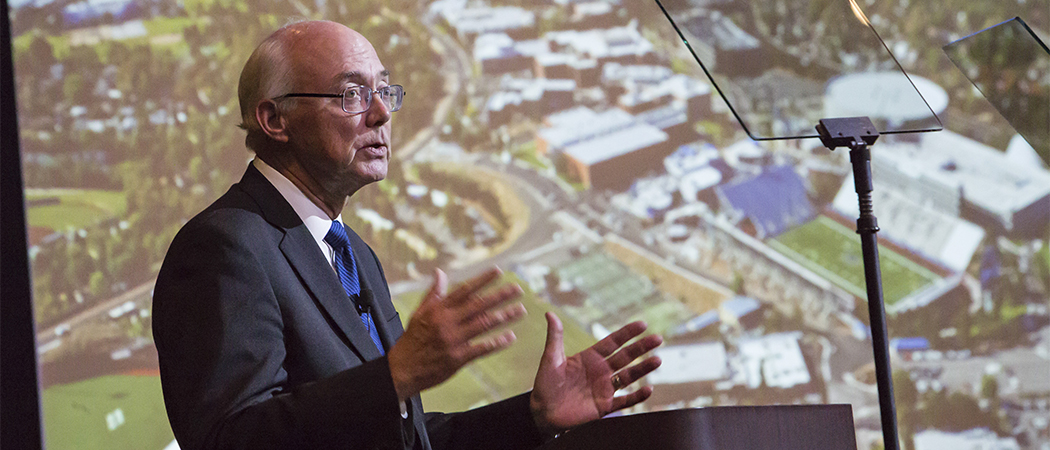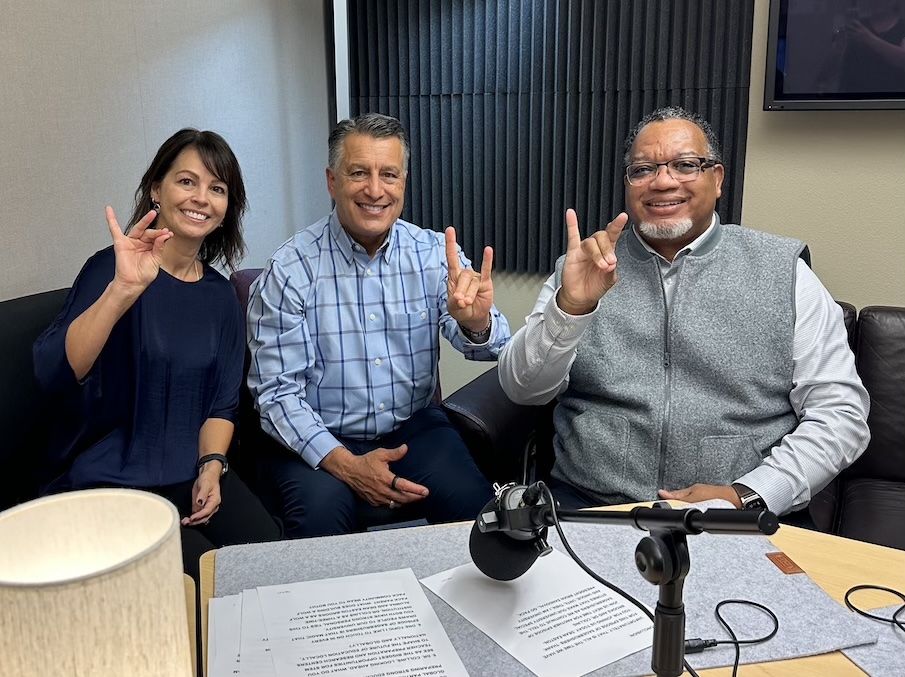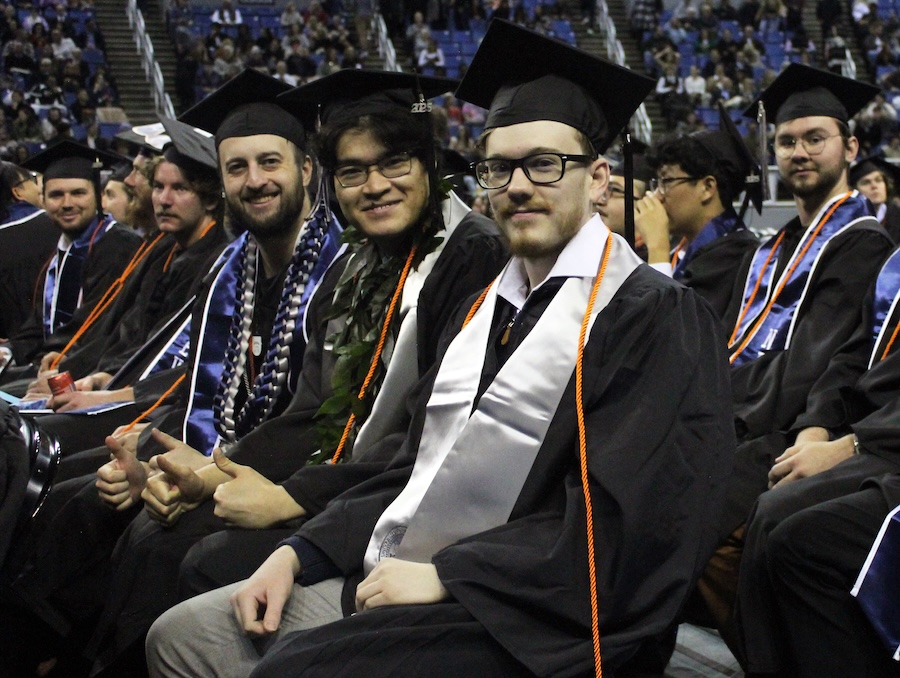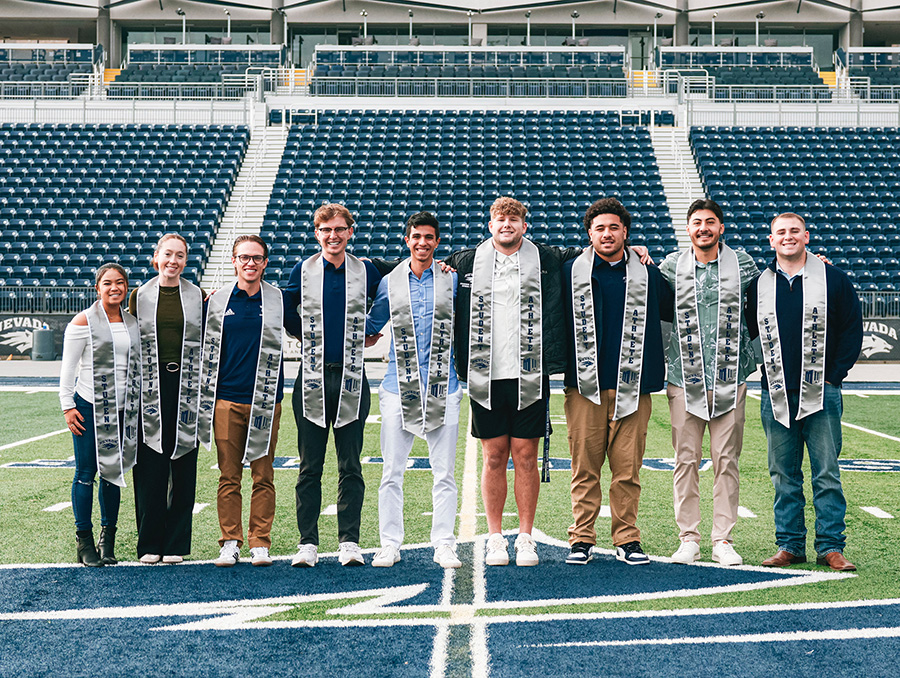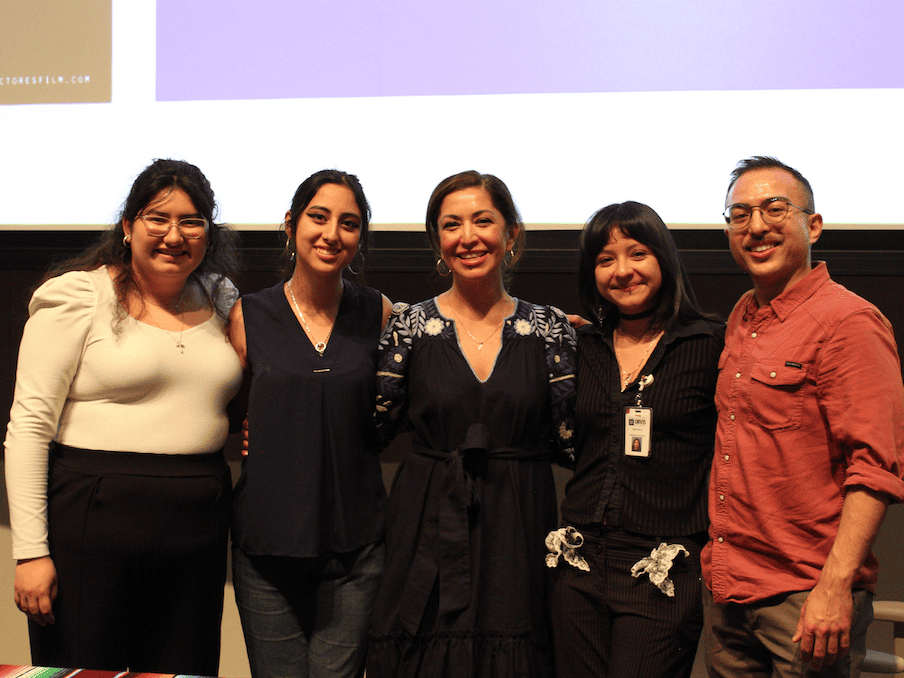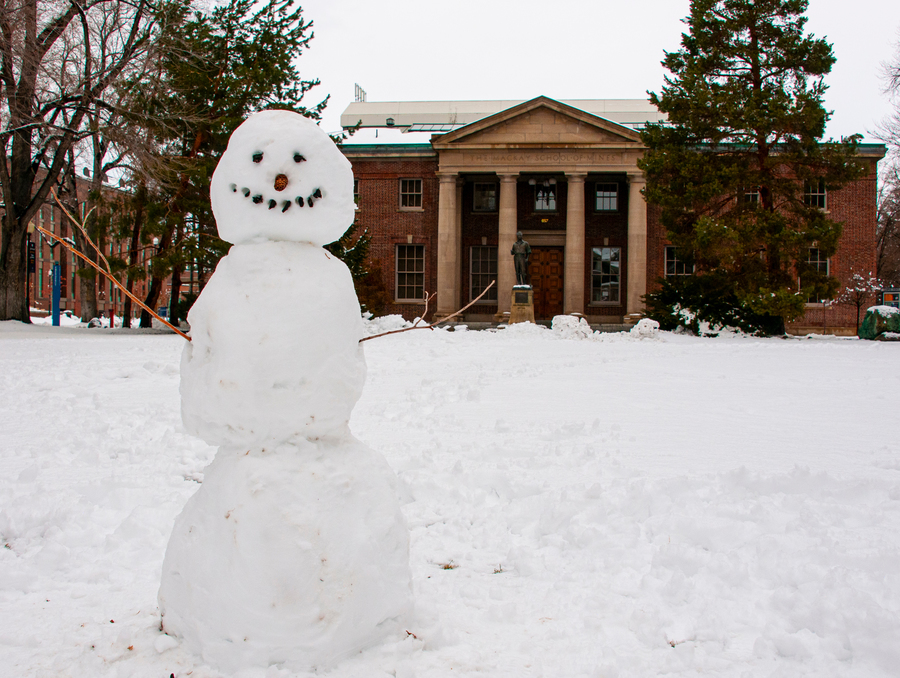President Marc Johnson detailed a rapidly growing present and a "transformational" future for the University of Nevada, Reno during his annual "State of the University" address on Sept. 29 in the Glick Ballrooms of the Joe Crowley Student Union.
Johnson's 36-minute address, "A Time of Transformation," was delivered before more than 250 people with many more viewing online. The president emphasized the nature and characteristics of the University's enrollment growth, how the institution is responding to growth, and the ways in which the institution is transforming the quality and depth of its three core missions of learning, discovery and engagement.
"This is a transformational moment for our University," Johnson said.
Johnson noted many of the milestones the University had achieved with the start of the fall semester. This included record enrollment (20,898 students), the largest freshman class ever (3,851 students), record numbers of National Merit and Presidential Scholars (more than 300), a 59 percent six-year graduation rate to be reported for the 2009 cohort, and a spot yet again among the top tier of "best national universities" by U.S. News & World Report in rankings that were released earlier this month.
"Our students are enjoying more success than ever," Johnson said, noting the freshman-to-sophomore retention rate of 81 percent.
Johnson also made a strong statement regarding the anonymous Coffin & Keys organization.
He quoted a recent Time Magazine article which noted how "vile, racist and hateful comments" are made on the Internet. The article quoted Plato, who once asked, "If we are shielded from the consequences of our actions, how would that change the way we act?"
"We have an unrecognized, anonymous group of students known as Coffin and Keys, and they have, unfortunately, shown their answer," Johnson said of Plato's question. "While we all value freedom expression as a foundation of our society, I want to make clear that words and actions, from groups like Coffin and Keys, that scare and denigrate women, members of the LGBT community, people of color and anyone else to whom they feel superior do not, as they claim, 'improve the university.'"
Johnson then pivoted back to student success, saying that efforts to enrich the student experience will be increasing in coming years, through a newly implemented Core Curriculum, which includes a "writing in the disciplines" initiative to help the institution's future graduates enter the marketplace with enhanced writing and communication skills, investment in support staff and academic advisors, plans for two new residential halls in 2017 and 2019, a continued emphasis on experiential learning in the classroom and on student well-being through wellness and fitness initiatives such as a tobacco-free campus and the construction of the E. L. Wiegand Fitness Center.
With the hiring of more than 400 faculty expected in the coming years, Johnson said one of the University's major goals is to reduce the student-to-faculty classroom ratio from 22-to-1 to 18-to-1, "so that learning can have a greater impact."
"There is increased emphasis on the return to the expectation that a college undergraduate degree is a four-year experience, followed by graduate school or a career," Johnson said. "Our four-year graduation rate is growing rapidly and the new emphasis and expectation will accelerate this rate. In the last two years, we have seen our students take more credits per term, resulting in shorter times to graduation."
While growth has been welcomed - Johnson said the University has been able to add faculty, support staff and services through increases in student enrollment, which in turn have provided funding through increased tuition and fees and the state's funding formula - he cautioned that increasing enrollments will also require a "careful balancing act" in the future.
"If we grow enrollment too fast, we will create a painful deficit of resources," he said. He then explained one- and three-year "lags" that are associated with the University's funding, "which provide resources after enrollment has occurred." A one-year lag exists from the time increased number of students arrived until the University could place additional faculty and staff on the campus. In addition, there is a three-year lag for state funds that come to the University from the state's funding formula.
"To completely avoid this lag in resources to match the level of enrollment would require a no-growth or stagnation position," Johnson said. "The balancing act is to plan for enrollment growth at a pace in which enrollment does not greatly outpace availability of resources."
Johnson said the University is engaged in an enrollment management strategy "that we believe will better calibrate, but not completely stop, our growth." The strategy includes:
Reducing the number of $1,000 scholarships the University awards to students who in the past have been on the less prepared end of academically qualified entrants;
Advancing the admissions deadline to April 7, which data show will slow growth slightly and improver retention and graduation rates;
Increase the qualifications for Western Undergraduate Exchange (WUE) students and raise tuition for those previously qualified for WUE beginning in fall 2016.
Related to the funding structure of the University, Johnson noted there have been significant enhancements over the past year. He highlighted a slide showing 41 new faculty positions added this year. The hires, he said, are part of a multi-year process, bringing the number of additional faculty to 101 hired in the past two years.
He said two major emphases are guiding the hiring process. Through a Request for Proposal process led by Provost Kevin Carman and in consultation with all of the colleges and faculty leadership, new faculty are being added in areas to address growth in student teaching demand to reduce the in-class student-to-faculty ratio, and, secondly, to hire in a "clustering" fashion to create programs of critical mass in topical areas that promise to yield competitive research capacity. This second goal, Johnson said, is critical if the University is to reach the Carnegie Foundation for the Advancement of Teaching classification of "Research University/Very High."
Faculty hire clusters are coming in several areas, including cyber security, neuroscience, dry land agricultural and environmental systems, autonomous systems, high performance computing, statistics, community health sciences, music and theater, big data and human development and family studies.
To meet the demand for space, Johnson said the University is responding with "new and renovated offices for offices and research laboratories." This includes the opening of the William N. Pennington Student Achievement Center early next year, conversion of Lincoln and Manzanita Halls from residence halls to offices, and comprehensive renovation of Palmer Engineering.
He explained the "domino effect" that will occur as new buildings open, occupants of old buildings move into new buildings, and new space is freed up.
Just as an example, Johnson noted that when the Pennington Student Achievement Building opens, student services areas such as counseling, disability resources, TRIO and career studio would move into the new building. Thompson Hall, where many of these services are now housed, would then be converted for offices for social sciences and humanities academic faculty, which would then open office and lab space in Mack Social Science.
In addition, new buildings are being planned in the arts, engineering and business as part of the comprehensive campaign, Johnson said. He reported that the comprehensive campaign has raised about $156 million.
Johnson said that although enrollment growth continues to be one of the defining issues for the University, it should not overshadow the larger message that the University has changed dramatically in recent years.
"In addition to this being a time of enrollment growth, this is also a time of transformation," he said. "The University is transforming and deepening the way we fulfill our missions. Northern Nevada is transforming with us into a hub of advanced manufacturing, of entrepreneurship, of creativity and quality of life."
Johnson said that earlier in the month, a profound moment occurred when Reno Mayor Hillary Schieve delivered her "State of the City" address on the University campus, in the Glick Ballrooms.
"One of the lines that resonated for me that evening was when the mayor said, 'Now, more than ever, we are a university town,'" Johnson said, smiling. "It was a powerful moment. It spoke to how, in a relatively brief time, our University and our community have joined in a clear path for the future."
Johnson used the Master Plan, the Strategic Plan and the adoption of the new Core Curriculum as key "transformations" that have been adopted and are being implemented by the University.
The Master Plan, Johnson explained, has "intentions to connect the University tangibly with the City of Reno." The plan envisions an expansion of the campus footprint south to Interstate 80 and the west edge of Evans Ave., with coordinated private development south of I-80 to downtown Reno.
Johnson said the University is also transforming its research culture. Using the aspiration of RU/VH as a guide, the goal is to enhance faculty opportunities for "research fulfillment, build undergraduate and graduate research opportunities, provide a foundation for scientific and business development, and raise the reputation of Nevada. We are creating new Ph.D. programs across the disciplines, in areas that promise to bring us national recognition."
Johnson also highlighted the University's efforts to build "an ecosystem that enables innovation, talent development, and improving the business climate" through academic and research initiatives as well as the opening of new facilities such as the Innevation Center, Powered by Switch.
The Innevation Center, which celebrated its grand opening last week, and located in downtown Reno, is envisioned as a hub of community, business and advanced manufacturing engagement.
"Such support is pivotal in helping faculty do foundational research, make breakthroughs, prove and shape scholarly perspective, license University intellectual properties, and form successful spin-off companies," Johnson said.
Johnson also cited the University of Nevada School of Medicine as an example of transformation. He said legislative funding over the biennium will help create a full, four-year campus in Reno, while developing a full, four-year medical school at UNLV.
"The vision and incremental funding will help the University of Nevada School of Medicine focus on primary care education and training with a research-intensive, community-based vision, new and strong hospital and community physician partnerships, and outreach to Nevada's rural areas.
"From this year on, students in the School of Medicine can plan on taking all four years here in Reno."
Through all of this effort, Johnson said the University continues to forge a strong reputation that is recognized in the West and nationally, including "a broad reach that includes students from 49 out of our 50 states and many foreign countries."
"What transformation we will ultimately achieve," Johnson concluded, "will be the result of our continued common vision ... and our commitment ... to the achievement of excellence that runs deeply through all the work and all the people of our University."
